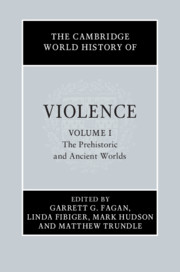Book contents
- The Cambridge World History of Violence
- The Cambridge History of Violence
- The Cambridge World History of Violence
- Copyright page
- Contents
- Figures
- Maps
- Contributors to Volume i
- General Introduction: Violence in World History
- Introduction to Volume I
- Part I The Origins of Conflict
- 1 The Origins of Warfare and Violence
- 2 Violence in Palaeolithic and Mesolithic Hunter-Gatherer Communities
- 3 Settled Lives, Unsettled Times: Neolithic Violence in Europe
- 4 Violence during the Later Stone Age of Southern Africa
- 5 Weapons, Warriors and Warfare in Bronze Age Europe
- 6 Weapons, Ritual and Warfare: Violence in Iron Age Europe
- 7 The Origins of Violence and Warfare in the Japanese Islands
- Part II Prehistoric and Ancient Warfare
- Part III Intimate and Collective Violence
- Part IV Religion, Ritual and Violence
- Part V Violence, Crime and the State
- Part VI Representations and Constructions of Violence
- Index
- References
5 - Weapons, Warriors and Warfare in Bronze Age Europe
from Part I - The Origins of Conflict
Published online by Cambridge University Press: 13 March 2020
- The Cambridge World History of Violence
- The Cambridge History of Violence
- The Cambridge World History of Violence
- Copyright page
- Contents
- Figures
- Maps
- Contributors to Volume i
- General Introduction: Violence in World History
- Introduction to Volume I
- Part I The Origins of Conflict
- 1 The Origins of Warfare and Violence
- 2 Violence in Palaeolithic and Mesolithic Hunter-Gatherer Communities
- 3 Settled Lives, Unsettled Times: Neolithic Violence in Europe
- 4 Violence during the Later Stone Age of Southern Africa
- 5 Weapons, Warriors and Warfare in Bronze Age Europe
- 6 Weapons, Ritual and Warfare: Violence in Iron Age Europe
- 7 The Origins of Violence and Warfare in the Japanese Islands
- Part II Prehistoric and Ancient Warfare
- Part III Intimate and Collective Violence
- Part IV Religion, Ritual and Violence
- Part V Violence, Crime and the State
- Part VI Representations and Constructions of Violence
- Index
- References
Summary
The emergence of a distinct warrior ideology across most parts of Europe occurred in the Bronze Age, marking a profound change in the management of conflict within prehistoric societies. Between the mid third and early first millennium BCE metal evolved from a rare commodity to a common resource used for violent activities, most notably in the form of swords, spears, shields and armour created for battle. Becoming increasingly common by the later part of this period, the scale and complexity of fortified sites transformed the organisation of violence in communities while also reshaping relationships between the built environment and societies by formalising inclusive and exclusive spaces in new ways. The people living through this period of change experienced violence in many venues, with bones preserving the most direct evidence. Violence as commemorated in art is illustrative of how the different societies of Europe understood its social purpose. Our sources demonstrate that across Europe children, women and men could be brutally attacked by weapons ranging from slings and arrows, suited to hunting, to swords and spears, designed for war. This chapter focuses mainly on changes in warfare-related violence due to the wealth of material remains suited to exploring this theme.
- Type
- Chapter
- Information
- The Cambridge World History of Violence , pp. 117 - 141Publisher: Cambridge University PressPrint publication year: 2020
References
Bibliographic Essay
- 11
- Cited by

